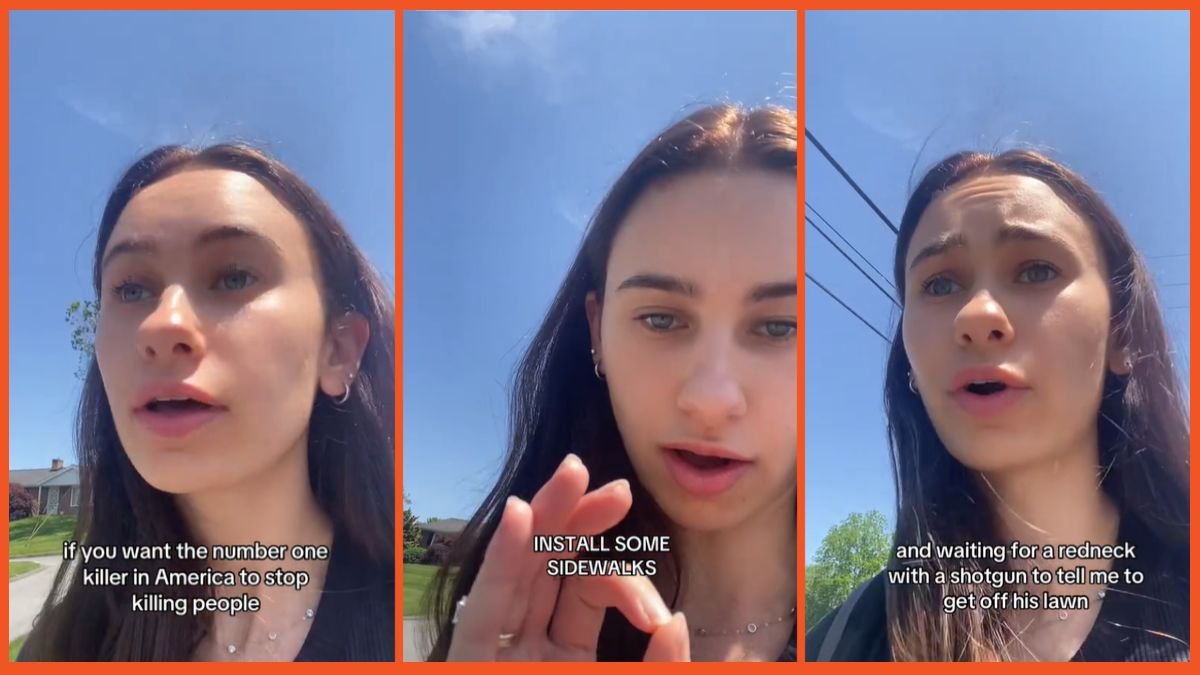Living in America can be a wild ride, and not always in a good way. Sure, we have got our freedom, our big trucks, and fast food joints, but when it comes to basic things like, oh I don’t know, being able to walk down the street without risking life and limb? Apparently, that’s asking too much.
Take the recent TikTok video by Gab Grassy (@gmgrassy), for example. She posted a clip of herself walking down a road, lamenting the lack of sidewalks and dodging obstacles just to sip on that Americano. “I just wanted to walk to a coffee shop; it’s not even far, it’s like 20 minutes away—that’s like a daily commute in Europe,” she says. “Instead, there are cars whizzing by me as I walk in the middle of the road, and I’m on people’s lawns, waiting for a redneck with a shotgun to tell me to get off his lawn.”
The response from across the pond was a resounding “WTF?” European viewers couldn’t believe their eyes. “No sidewalks anywhere?! Whaaaaa,” one commented. “Why does America hate sidewalks or just anything that will make life functional?” one commenter asked, while another pondered, “What are y’all even doing?”
It’s not just the lack of sidewalks that sets America apart. It’s the entire car-centric culture that prioritizes vehicles over people. In many European cities, pedestrians reign supreme, with extensive networks of sidewalks, crosswalks, and car-free zones. Public transportation is efficient, reliable, and widely used, reducing the need for personal vehicles. And let’s not forget the joy of sipping an espresso at a sidewalk café, watching the world go by at a leisurely pace.
Contrast that with the American experience, where cities are designed around highways and parking lots, and walking is often seen as a last resort for the careless and the masochistic. Even in cities with decent sidewalks, pedestrians are often an afterthought, forced to navigate a maze of construction detours, poorly timed crosswalks, and aggressive drivers who view them as little more than speed bumps. And if you’re one of the millions of Americans who rely on public transportation, well, godspeed to you. Between the delays, the overcrowding, and the mysterious sticky substances on the seats, it’s like playing a game of “Will I Make It to Work on Time, or Will I Contract a Rare Fungal Infection?” (Spoiler alert: It’s usually both.)
This peculiar approach to urban planning is symptomatic of a broader tendency in American policy and practice. The U.S. clings to the imperial measurement system long after the rest of the world has adopted the metric system, which can perplex even its citizens — ask an American friend how many fluid ounces were in a gallon, and they will look at you like you’d just asked them to explain quantum physics. More serious, however, are the absence of universal healthcare and affordable education. But the absence of something as basic as sidewalks in so many places really takes the cake.
As Grassy points out, it’s not just a matter of convenience — it’s a matter of safety. Pedestrian deaths have been on the rise in recent years, with over 7,000 people killed in 2021 alone, according to the Governors Highway Safety Association. That’s the highest number in more than 40 years.
So what’s the deal, America? Why are we so resistant to the idea of creating spaces that prioritize people over cars? Many commentators on Grassy’s video speculated that it might have something to do with the influence of the gas and oil industries. “I think the government is getting paid by gas and gas companies to not allow walkable cities,” one user wrote. And while there’s certainly some truth to that, it doesn’t explain the whole picture. After all, Europe has plenty of cars too, but somehow they have managed to create cities that are both drivable and walkable.
Fortunately, some cities like Portland and Seattle have made great strides in recent years to prioritize pedestrian and bike infrastructure, with impressive results. So, it’s not like we don’t have the resources or the know-how to fix this problem. Maybe instead of spending billions on space exploration or military equipment, we could invest in more common-sense infrastructure, sensible gun laws, and a social safety net that doesn’t leave people choosing between rent and insulin.






Published: Jul 6, 2024 09:06 am